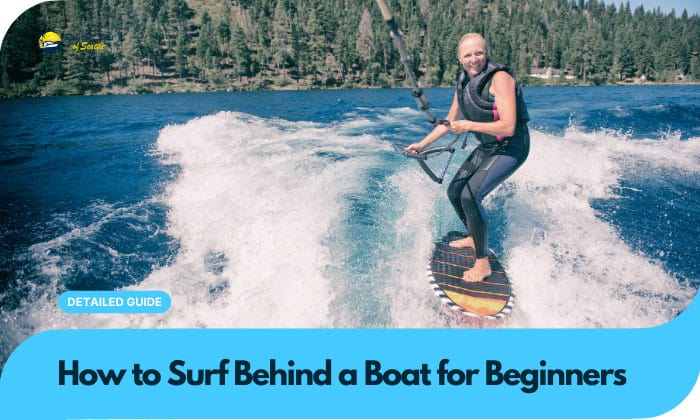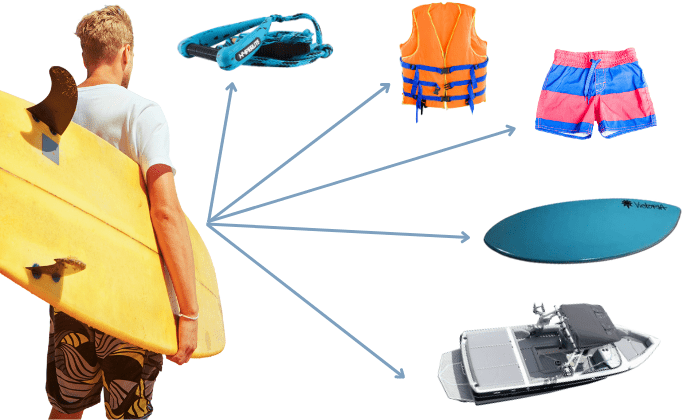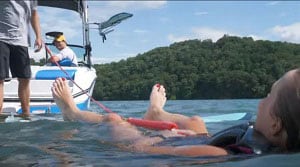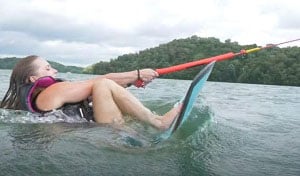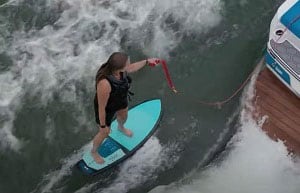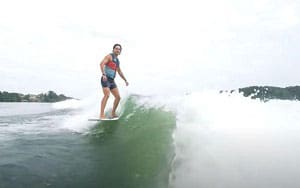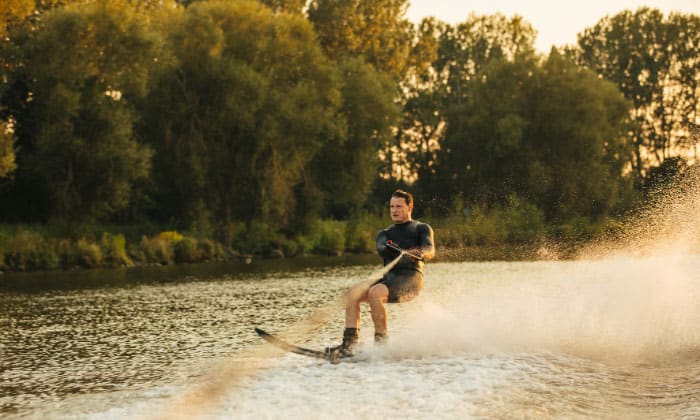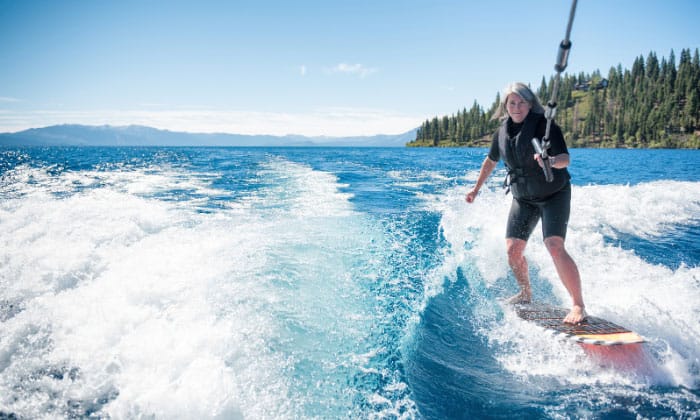More and more weekend wave riders are ditching their wakeboards for skimboards or surfboards. And if you have friends already into this aqua sport, you might want to start learning how to surf behind a boat for beginners.
Some folks believe that wake surfing is inherently more challenging than wakeboarding because you do not have a rope “towing” you behind a boat. However, learning to wakesurf is breezier than knowing how to wakeboard. We will show you can ace this aqua sport in a few sessions.
Let us start.
Table of Contents
Steps to Surf Behind a Boat for Beginners
What to prepare
- Boat with a V-drive or inboard motor (we recommend getting a wake surfing boat because the surfing boat price is not that high – you can get one for less than $30,000)
- Personal flotation device (i.e., life jacket)
- Wakesurf board or a suitable alternative (i.e., skimboard)
- Board shorts
- Wake surfing rope
Step 1. Position yourself on the wake surfboard
This step is one of the trickiest to master, especially for greenhorn wake surfers. Unfortunately, it is the most vital aspect of surfing behind a boat. So, how to start? Please note the following sub-steps.
- Wear your life jacket and grab the wake surfing rope’s handle, ensuring you are at least 15 feet from the tow boat’s stern. You can observe a 20-foot safe distance if you want.
Although wake surfing behind a boat with a rope is non-existent, you still need a cord to pull yourself up on the surfboard as the vessel picks up speed.
- Assume a sitting position in the water and place the wake surfboard at your front while holding the surfing rope’s handle with one hand.
- Place your arms over your knees. Position your heels on the wake surfboard, ensuring the toes point up.
- Pro tip: You might want to practice this position on dry land several times before wake surfing.
Step 2. Slowly pull yourself on the wake surfboard as the boat picks up speed.
This step is trickier than Step 1, with many newbie wake surfers falling flat on their faces, hitting the brick wall-like water and dampening their spirits. Here is how you can accomplish this step.
- Give your pilot the go-signal to fire up the engine and slowly accelerate. The boater should know how to set up boat for wakesurfing to create the ideal water conditions for the sport.
- Feel the surfing rope tighten, and get ready to pull yourself up on the wake surfboard.
- “Plant” your heels firmly onto the surfboard, ensuring its top surface faces you and its underside faces the oncoming water. This action will help you to secure your feet squarely onto the surfboard.
- Draw your knees toward your chest and assume a crunch position.
- Carefully pull yourself up on the wake surfboard and stand on it while maintaining a firm grip on the surfing rope handle. Keep your heels firmly on the surfboard to maintain stability when standing.
An experienced wake surf boater knows when to accelerate to facilitate easier and safer “standing up on the wake surfboard.”
Step 3. Find the “sweet spot.”
Balancing on a static boat is easy (such as when you are practicing on solid ground). Unfortunately, wake surfing in the water is different. Finding the right “balance” or “sweet spot” can differentiate between acing the beginner wakesurf tricks and frequent wipeouts.
- Assume the “normal” surfing stance by placing your left foot at the surfboard’s front section and the right foot at the back. You can do the opposite if you are lefty or more comfortable with it.
- Adjust your weight front or back to find the “sweet spot.” Please remember that shifting your weight up front increases your speed. Pressing your weight on the surfboard’s rear slows it down.
- Start surfing the “artificial” waves. Do not let go of the surfing rope until you are confident enough.
Step 4. Let go of the rope and start wake-surfing.
It is okay if you only reached Step 3 in your first several attempts. Repetition can help you build and boost confidence, allowing you to let go of the surfing rope in this step.
- Observe the surfing rope tension. Cord slackening without losing your “sweet spot” indicates growing confidence and mastery of balancing on the surfboard.
- Ditch the surfing rope when 100% sure you can maintain balance and surf the waves without embarrassing wipeouts. You can toss it to someone on the boat or throw it in the waves.
- Start with easy wakesurf tricks. You can always add a few more or venture into more advanced wake surfing techniques as you grow your confidence.
Use this step to get around surf control, building confidence each time and accumulating more tricks on the water.
You might also want to communicate with your pilot to keep the boat at the ideal speed. If you are wondering about the best speed for wakesurfing, that would be between 10 and 15 miles per hour or 8.7 to 13 knots.
Tips and Tricks for Surfing Behind Boat for Beginners
We compiled the following wake surfing tips and tricks to help beginners find this aqua sport more enjoyable and fulfilling.
- Avoid pulling yourself over the wake surfboard. Otherwise, you will fall face-first into the water.
- Please resist the temptation of letting your head fall backward. This head movement is a natural result of getting pulled. Unfortunately, doing it on a wake surfboard could result in another wipeout.
- Maintain the correct wake surfing posture, especially when approaching a wave. You can press your lower back with your free hand to help prop up your stance.
- Always toss the surfing rope into the boat or have someone onboard pull it out of the water. Leaving the surfing cord in the water can be dangerous because it could snag your surfboard or wrap you with it.
- Please remember that shifting your weight forward increases your speed, and pressing the back foot slows you down.
- Try to anticipate the wake surfboard’s movements because it takes a few seconds to increase or decrease speed after shifting on the front or back foot.
- Signal the pilot to maneuver the vessel toward the wave’s side if you want to decelerate quickly.
- Keep your shoulders and hips facing the wave to ensure surfboard stability and balance.
- Learn to drive or steer the wake surfboard with your hips. Hence, you can move your hips backward to decelerate instead of shifting your shoulders to the rear. It is the opposite stance if you want to speed up.
- Be mindful of keeping your feet firmly planted on the surfboard’s center to help you stay on the boat-created wave and avoid wipeouts.
- Apply pressure on your soles to help keep the ideal wake surfing posture.
FAQs
Can you wake surf behind any boat?
Yes, you can wake surf on almost any boat, provided it meets the minimum requirements for a wake surfing vessel.
The ideal watercraft for wake surfing must have its propellers submerged and underneath the boat’s bottom hull. Hence, you can surf behind a ski boat with a V-drive or inboard motor.
Although vessels with outboard motors can also function as wake surfing boats, the motor and propeller’s proximity to the surfer makes them risky.
Ideally, the boat should be 18 feet long and with a deep-V hull design. These characteristics are necessary to create a wake with pockets for surfing.
Is wake surfing dangerous?
Although wake surfing speed is lower than wakeboarding, it can still be dangerous, especially among newbies.
The 10-foot recommended distance between the surfer and the boat can increase the risk of accidents. One wrong move can shift the surfer’s weight forward, catapulting the surfer towards the boat’s stern.
The degree of danger increases when performing wake surfing tricks, especially those meant for advanced surfers, and you are still a greenhorn to this aqua sport.
How to wakesurf without rope?
Please note that wake surfing requires a rope only to launch the surfer from the water and get up on a wake surf. The surfer lets go of the cord once they feel ready to surf.
Once you let go of the rope, you can now do wake surfing. The key here is to find the surfboard’s neutral. Shifting your weight towards the surfboard’s front increases speed. Meanwhile, making the surfboard’s backend heavier will lead to deceleration.
Keep your shoulders and hips facing the wave. Moreover, maintain your “sweet spot” to keep the “edge.” Here is a video worth watching.
Conclusion
How to surf behind a boat for beginners is an easy three-step process. Although this how-to guide outlined four steps, we do not recommend progressing to the last step until you have enough mastery and confidence to execute the first three.
We advise aspiring wake surfers to practice the first three steps on dry land by simulating the actions with friends or family members. You will want to develop and strengthen muscle memory to make the wake surfing movements seem like second nature.

Ten years of enjoying countless trips on boats never made me love them any less! So I am here to put all those experiences into good use for other boaters who want to have a safe and fun trip with their friends and families.

